The topic of this article may not meet Wikipedia's general notability guideline .(April 2023) |
QKENCHANT was a Central Intelligence Agency project used to provide security approvals on non-Agency personnel and facilities. [1]
The topic of this article may not meet Wikipedia's general notability guideline .(April 2023) |
QKENCHANT was a Central Intelligence Agency project used to provide security approvals on non-Agency personnel and facilities. [1]
In a memorandum to Assassination Records Review Board, dated 18 September 1998, Central Intelligence Agency states the following:
In a memorandum for "JFK Declassification Project of CIA, dated 27 February 1998, the [redacted] sender entity states:
Intelligence officer E. Howard Hunt was associated with QKENCHANT. Hunt, with G. Gordon Liddy and others, was one of the White House's "plumbers"—a secret team of operatives charged with fixing "leaks". [2]
CIA cryptonyms are code names or code words used by the U.S. Central Intelligence Agency (CIA) to refer to projects, operations, persons, agencies, etc.

Operation Northwoods was a proposed false flag operation against American citizens that originated within the US Department of Defense of the United States government in 1962. The proposals called for CIA operatives to both stage and commit acts of violent terrorism against American military and civilian targets, blaming them on the Cuban government, and using it to justify a war against Cuba. The possibilities detailed in the document included the remote control of civilian aircraft which would be secretly repainted as US Air Force planes, a fabricated 'shoot down' of a US Air Force fighter aircraft off the coast of Cuba, the possible assassination of Cuban immigrants, sinking boats of Cuban refugees on the high seas, blowing up a U.S. ship, and orchestrating terrorism in U.S. cities. The proposals were rejected by President John F. Kennedy.

Everette Howard Hunt Jr. was an American intelligence officer and author. From 1949 to 1970, Hunt served as an officer in the Central Intelligence Agency (CIA), particularly in the United States involvement in regime change in Latin America including the 1954 Guatemalan coup d'état and the 1961 Bay of Pigs invasion. Along with G. Gordon Liddy, Frank Sturgis, and others, Hunt was one of the Nixon administration "plumbers", a team of operatives charged with identifying government sources of national security information "leaks" to outside parties. Hunt and Liddy plotted the Watergate burglaries and other clandestine operations for the Nixon administration. In the ensuing Watergate scandal, Hunt was convicted of burglary, conspiracy, and wiretapping, eventually serving 33 months in prison. After release, Hunt lived in Mexico and then Florida until his death.
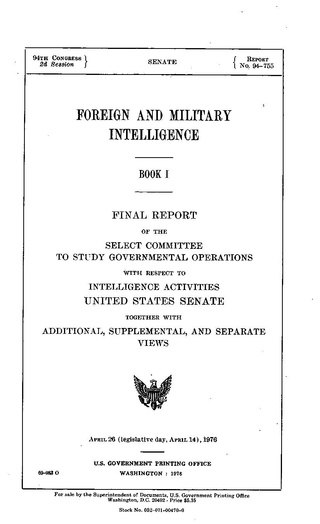
The Church Committee was a US Senate select committee in 1975 that investigated abuses by the Central Intelligence Agency (CIA), National Security Agency (NSA), Federal Bureau of Investigation (FBI), and the Internal Revenue Service (IRS). Chaired by Idaho Senator Frank Church (D-ID), the committee was part of a series of investigations into intelligence abuses in 1975, dubbed the "Year of Intelligence", including its House counterpart, the Pike Committee, and the presidential Rockefeller Commission. The committee's efforts led to the establishment of the permanent US Senate Select Committee on Intelligence.
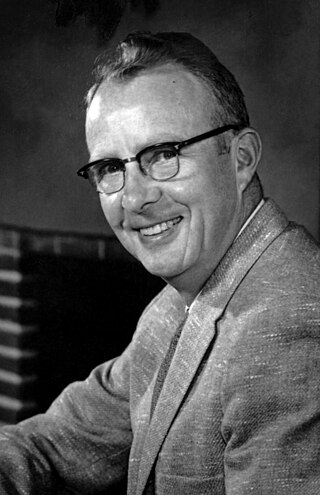
The Robertson Panel was a scientific committee which met in January 1953 headed by Howard P. Robertson. The Panel arose from a recommendation to the Intelligence Advisory Committee (IAC) in December 1952 from a Central Intelligence Agency (CIA) review of the U.S. Air Force investigation into unidentified flying objects, Project Blue Book. The CIA review itself was in response to widespread reports of unidentified flying objects, especially in the Washington, D.C. area during the summer of 1952.

The Cuban Project, also known as Operation Mongoose, was an extensive campaign of terrorist attacks against civilians, and covert operations, carried out by the U.S. Central Intelligence Agency in Cuba. It was officially authorized on November 30, 1961 by U.S. President John F. Kennedy. The name Operation Mongoose had been agreed at a prior White House meeting on November 4, 1961. The operation was run out of JM/WAVE, a major secret United States covert operations and intelligence gathering station established a year earlier in Miami, Florida. It was led by United States Air Force General Edward Lansdale on the military side and William King Harvey at the CIA and went into effect after the failed Bay of Pigs Invasion.

Project FUBELT is the codename for the secret Central Intelligence Agency operations that were to prevent Salvador Allende's rise to power before his confirmation and to promote a military coup in Chile. This project came after the circumstantial failure of Track I, which involved making president Eduardo Frei Montlava interfere with the 1970 national election in opposition to Allende.
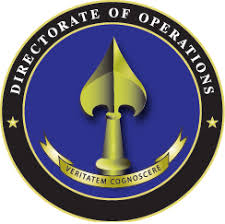
The Directorate of Operations (DO), less formally called the Clandestine Service, is a component of the US Central Intelligence Agency. It was known as the Directorate of Plans from 1951 to 1973; as the Directorate of Operations from 1973 to 2005; and as the National Clandestine Service (NCS) from 2005 to 2015.

The Central Intelligence Agency, known informally as theAgency and historically as thecompany, is a civilian foreign intelligence service of the federal government of the United States, officially tasked with gathering, processing, and analyzing national security information from around the world, primarily through the use of human intelligence (HUMINT) and conducting covert action. As a principal member of the United States Intelligence Community (IC), the CIA reports to the Director of National Intelligence and is primarily focused on providing intelligence for the President and Cabinet of the United States. Following the dissolution of the Office of Strategic Services (OSS) at the end of World War II, President Harry S. Truman created the Central Intelligence Group under the direction of a Director of Central Intelligence by presidential directive on January 22, 1946, and this group was transformed into the Central Intelligence Agency by implementation of the National Security Act of 1947.

On March 1, 1967, New Orleans District Attorney Jim Garrison arrested and charged New Orleans businessman Clay Shaw with conspiring to assassinate President Kennedy, with the help of Lee Harvey Oswald, David Ferrie, and others. On January 29, 1969, Shaw was brought to trial in Orleans Parish Criminal Court on these charges. On March 1, 1969, a jury took less than an hour to find Shaw not guilty. It remains the only trial to be brought for the assassination of President Kennedy.
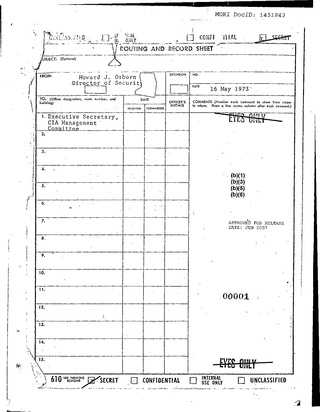
The "Family Jewels" is the name of a set of reports detailing illegal, inappropriate and otherwise sensitive activities conducted by the Central Intelligence Agency from 1959 to 1973. William Colby, the CIA director who received the reports, dubbed them the "skeletons in the CIA's closet". Most of the documents were released on June 25, 2007, after more than three decades of secrecy. The non-governmental National Security Archive filed a request for the documents under the Freedom of Information Act fifteen years before their release.
Lucien Emile "Lou" Conein was a French-American citizen, noted U.S. Army officer and OSS/CIA operative. Conein is best known for his instrumental role in the November 1963 coup against Ngô Đình Diệm and Diệm's assassination by serving as Ambassador Henry Cabot Lodge Jr.'s liaison officer with the coup plotters and delivering $42,000 of the known cash disbursements.

The President John F. Kennedy Assassination Records Collection Act of 1992, or the JFK Records Act, is a public law passed by the United States Congress, effective October 26, 1992. It directed the National Archives and Records Administration (NARA) to establish a collection of records to be known as the President John F. Kennedy Assassination Records Collection. It stated that the collection shall consist of copies of all U.S. government records relating to the 1963 assassination of President John F. Kennedy, and that they are to be housed in the NARA Archives II building in College Park, Maryland. The collection also included any materials created or made available for use by, obtained by, or otherwise came into the possession of any state or local law enforcement office that provided support or assistance or performed work in connection with a federal inquiry into the assassination.
National governments deal in both intelligence and military special operations functions that either should be completely secret, or simply cannot be linked to the sponsor. It is a continuing and unsolved question for governments whether clandestine intelligence collection and covert action should be under the same agency. The arguments for doing so include having centralized functions for monitoring covert action and clandestine HUMINT and making sure they do not conflict, as well as avoiding duplication in common services such as cover identity support, counterespionage, and secret communications. The arguments against doing so suggest that the management of the two activities takes a quite different mindset and skills, in part because clandestine collection almost always is on a slower timeline than covert action.
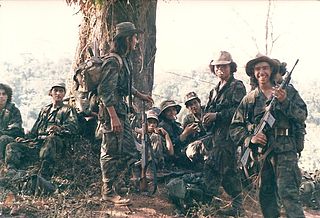
CIA activities in Nicaragua have been ongoing since the 1980s. The increasing influence gained by the Sandinista National Liberation Front, a left-wing and anti-imperialist political party in Nicaragua, led to a sharp decrease in Nicaragua–United States relations, particularly after the Nicaraguan Revolution. In 1981, President Ronald Reagan authorized the Central Intelligence Agency to support the Contras, a right-wing Nicaraguan political group to combat the influence held by the Sandinistas in the Nicaraguan government. Various anti-government rebels in Nicaragua were organized into the Nicaraguan Democratic Force, the first Contra group, at the behest of the CIA. The CIA also supplied the Contras with training and equipment, including materials related to torture and assassination. There have also been allegations that the CIA engaged in drug trafficking in Nicaragua.
The Congo, short for the Democratic Republic of the Congo, is an equatorial country located in central Africa. As of July 2018, the CIA World Factbook lists the Congo containing over 85 million inhabitants representing over 200 African ethnic groups. French is the country's official language, and Catholics comprise the largest religious group at fifty percent. The Congo was colonized by King Leopold II of Belgium in 1885, and known as Belgian Congo until independence in 1960. In recent decades, the CIA has been involved in the Democratic Republic of the Congo, especially in relation to the CIA's considerations and plans to assassinate former Prime Minister Patrice Lumumba. Patrice Lumumba was the legally elected first prime minister of the independent country. Lumumba was killed on January 17, 1961, at the age of thirty-five near Élisabethville, Katanga. Even before the independence of the Congo, the U.S. government attempted to facilitate the election of a pro-western government by identifying and supporting individual pro-U.S. leaders. The CIA was also notably involved in a campaign against Lumumba's successor, which led to his eventual imprisonment and long exile from the Democratic Republic of the Congo. The CIA was also a vital part of the United States' efforts to aid Joseph Mobutu, who took control of the Congo in 1965 and renamed the country Zaire and himself Mobutu Sese Seko. The CIA would work heavily with Mobutu, particularly in relation to American support for the National Liberation Front of Angola and Jonas Savimbi's National Union for the Total Independence of Angola.
At various times since the creation of the Central Intelligence Agency, the Federal government of the United States has produced comprehensive reports on CIA actions that marked historical watersheds in how CIA went about trying to fulfill its vague charter purposes from 1947. These reports were the result of internal or presidential studies, external investigations by congressional committees or other arms of the Federal government of the United States, or even the simple releases and declassification of large quantities of documents by the CIA.
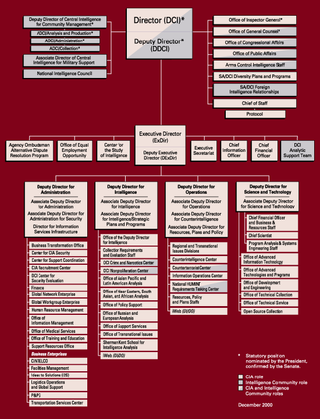
The CIA publishes organizational charts of its agency. Here are a few examples.
The CIA Kennedy assassination is a prominent John F. Kennedy assassination conspiracy theory. According to ABC News, the Central Intelligence Agency (CIA) is represented in nearly every theory that involves American conspirators. The secretive nature of the CIA, and the conjecture surrounding high-profile political assassinations in the United States during the 1960s, has made the CIA a plausible suspect for some who believe in a conspiracy. Conspiracy theorists have ascribed various motives for CIA involvement in the assassination of President Kennedy, including Kennedy's firing of CIA director Allen Dulles, Kennedy's refusal to provide air support to the Bay of Pigs invasion, Kennedy's plan to cut the agency's budget by 20 percent, and the belief that the president was weak on communism.
The Report on the Covert Activities of the Central Intelligence Agency is a 69-page formerly classified comprehensive study on the personnel, security, adequacy, and efficacy of the Central Intelligence Agency written by Lieutenant General James H. Doolittle. United States President Dwight Eisenhower requested the report in July 1954 at the height of the Cold War and following coups in Iran and Guatemala. The report compares with other contemporary Cold War documents such as George Kennan's "X" article in Foreign Affairs, which recommended a policy of "containment" rather than direct confrontation with the Soviet Union, and NSC 68, the secret policy document produced in 1950, which recommended a similarly restrained policy of “gradual coercion.” Doolittle wrote with an abandon-all-principles approach that conveyed the national fear that the United States faced the prospect of annihilation at the hands of the Soviet Union: “It is now clear that we are facing an implacable enemy whose avowed objective is world domination by whatever means and at whatever cost,” Doolittle wrote. “There are no rules in such a game… If the United States is to survive, long standing concepts of ‘fair play’ must be reconsidered.” Doolittle’s forceful policy and language reflected the fear that motivated American citizens and policymakers in the wake of Soviet Communism.